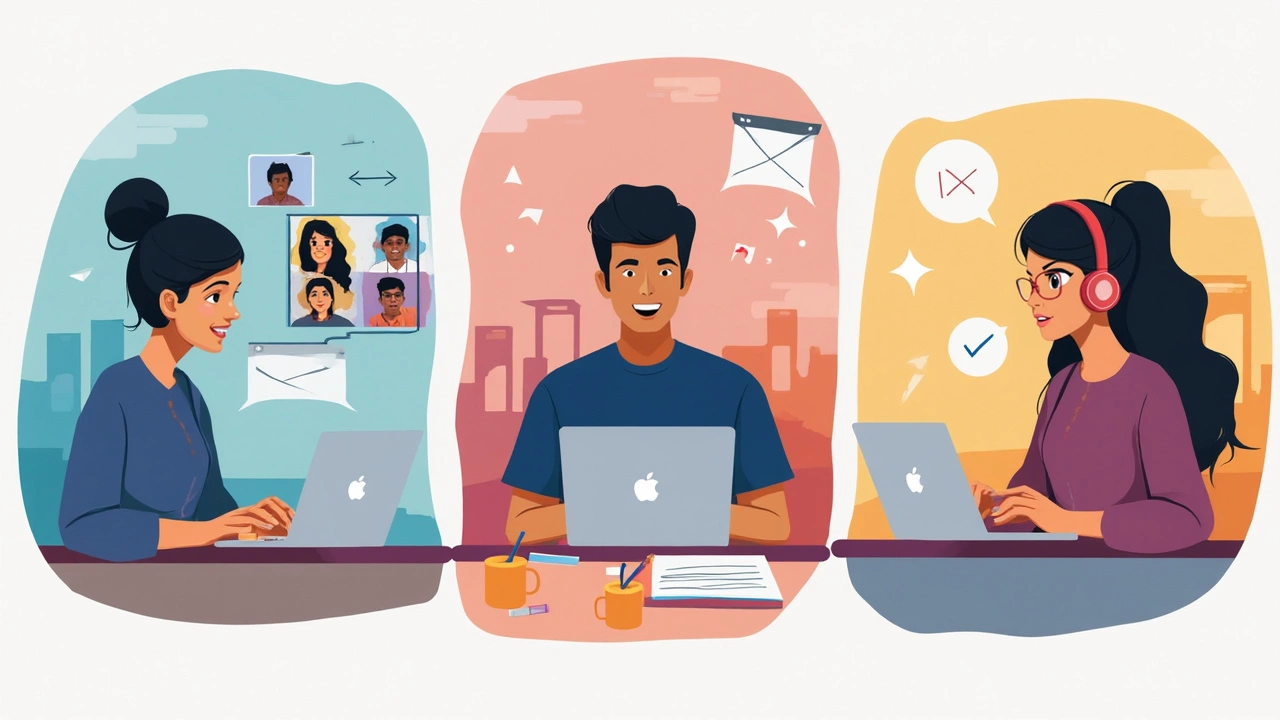You’d think eLearning would be simple, but there’s more than one way to do it—and not all online courses are created equal. Ever signed up for a course thinking you’d get live classes, only to find out it was all pre-recorded videos? Happens more than you’d think.
This is where knowing the three main types of eLearning really pays off. You can pick what actually fits your schedule, your learning style, and even your personality. Maybe you want someone to teach you live, or maybe you just want to hit play on your own time. Some people need a mix of both. We’ll walk through these types without fluff, just straight to what matters—so you can spot which eLearning setup works best before you even click ‘enroll’.
- Live Online Learning (Synchronous)
- Self-Paced Online Learning (Asynchronous)
- Blended Learning: Mixing Online and Offline
- Choosing the Right Type for You
Live Online Learning (Synchronous)
Live online learning—sometimes just called synchronous learning—means you’re in a virtual classroom with your instructor and classmates at the exact same time. Think of it like Zoom school: you log in at a set hour, follow the teacher in real-time, and can ask questions or give answers right then and there. With most eLearning platforms, these sessions often use video conferencing tools like Zoom, Microsoft Teams, or Google Meet.
One huge plus is interaction. If you’re the type who learns better with real-time feedback or needs the pressure of showing up at a certain time, live online learning can be a lifesaver. You can:
- Join breakout groups for discussions or projects
- Answer polls or quizzes live
- Get instant feedback from instructors
- See and chat with classmates for group work or study sessions
It’s not all sunshine though. You need to be there on schedule, which doesn’t work for everyone—especially if you’re balancing work or a wonky time zone. Some platforms record the live sessions, but honestly, you lose some magic when you’re not part of the action.
| Pros | Cons |
|---|---|
| Instant feedback, real-time Q&A, live discussion | Less flexible, must attend at specific times |
| Network with peers and instructors | Tech issues can disrupt learning |
If you’re eyeing live online learning, make sure your internet connection is strong and you’re comfortable jumping in with questions. Some instructors remember you better if you participate, which can help later on if you need references or extra support.
Self-Paced Online Learning (Asynchronous)
This one’s a real game-changer for folks who hate set schedules. Self-paced online learning (yeah, the fancy word is asynchronous) is what you’ll find on platforms like Coursera, Udemy, or even Duolingo. You just sign in, choose your course, and learn on your own clock—midnight, lunch break, whenever the mood strikes. There’s no live teacher waiting for you to log in at a certain time.
So, what do you actually get? Usually, you’ll see a mix of pre-recorded video lessons, reading materials, quizzes, and sometimes interactive stuff like discussion boards. Some courses throw in assignments you can upload and get feedback on. The neat part is, you can rewatch tricky videos or pause if your dog (looking at you, Max) starts barking at the mailman. It really fits if you’ve got an unpredictable routine or just prefer to learn bit by bit.
- Course examples: Coding bootcamps, Excel tutorials, photography basics—you name it. Most job skills stuff is offered asynchronously.
- Popular platforms: Coursera, LinkedIn Learning, Udemy, Skillshare, and Khan Academy all run self-paced courses.
Here’s an interesting thing: Studies show that more than 60% of learners choose self-paced eLearning for job-related training—because you don’t have to juggle work hours around class times (eLearning types really matter at work). Plus, most big companies like IBM and Google use this model to train people in bulk.
| Pros | Cons |
|---|---|
| Go at your own speed | No live feedback |
| Revisit tricky topics anytime | Less direct interaction with peers |
| Fits any routine, anywhere | Self-motivation needed |
Tip: Don’t just watch the videos and move on. Try out quizzes, join the forum chats, or redo challenging exercises. The people who really nail these online learning courses are the ones who actually practice and interact, even if nobody’s making them.

Blended Learning: Mixing Online and Offline
If you’ve ever thought, “I wish I could learn at my own pace but still ask questions in person,” blended learning is what you’re after. It’s the best of both worlds—mixing physical classroom sessions with online tools from e-learning platforms. Schools use this, companies use it for job training, even language centers jump in. Why? Because a mix just works for most people.
Here’s how blended learning usually rolls out:
- You watch or read lessons online—these could be videos, articles, and quizzes. Totally on your time, whether it’s morning coffee or those random midnight study sprints.
- Then you meet face-to-face (or sometimes in a live video call) to practice, discuss, or do hands-on stuff. This is the place to ask real questions, work in groups, or get feedback.
This isn’t just some fad. According to a meta-analysis by the U.S. Department of Education, students in blended learning environments performed better than those in just online or just face-to-face. That’s a solid reason to consider it if you’re serious about getting results.
| Aspect | Fully Online | Fully Offline | Blended Learning |
|---|---|---|---|
| Flexibility | High | Low | Medium |
| Human Interaction | Low | High | High |
| Feedback Speed | Medium | High | High |
Practical tip: Most eLearning types on today’s platforms offer a blended model for things like tech skills, language learning, and healthcare training. If your course offers live sessions or on-campus days along with online modules, that’s blended. Always check what percentage is online and what needs you to show up—so you’re not caught off guard. Mixing lets you get instant feedback when needed, but also means you don’t waste time sitting in a classroom for stuff you can learn solo at home.
If you want engagement with teachers but a bit of freedom, blended learning really nails that balance. It’s why companies love it for onboarding and upskilling employees. The mix means you pick up real skills, but also get tech know-how from using the strongest online learning tools out there.
Choosing the Right Type for You
It’s tempting to just jump into any online course you find, but trust me, picking the right eLearning type makes a world of difference. It’s not only about the topic—how you learn matters just as much. The three main models—live, self-paced, and blended—each work best for different folks and goals.
If you like real-time interaction, immediate feedback, and feel energized by group discussions, Live Online Learning (Synchronous) is your best bet. It gives a classroom vibe but online. You’ll usually have set times for classes, just like in school, so you need to commit to showing up. These courses use tools like Zoom, Teams, or Google Meet. According to a 2023 survey by Class Central, 38% of adults say they learn best when they can ask questions and get answers quickly from an instructor—so you’re not alone if you feel this way.
But maybe your work schedule jumps around, or kids/pets (shout-out to Luna and Max) keep you busy at odd times. Self-Paced Online Learning (Asynchronous) is built for flexibility. No live sessions—everything is on-demand, from videos to quizzes. This isn’t just about convenience; studies from Harvard’s online learning group show that people remember more when they can pause and replay at their own pace. If you’re a late-night learner, this type means you’ll never miss a class because you were walking your dog or making coffee.
Then there’s Blended Learning. This mixes both live and self-paced parts, and a lot of workplaces use it for training. Imagine having live video workshops every couple of weeks, but the rest is solo work done online whenever you want. If you want structure but still need wiggle room, blended is a solid call. Here’s a breakdown to help you compare:
| eLearning Type | Best For | Schedule | Interaction |
|---|---|---|---|
| Live Online | People who like real-time help | Fixed | High |
| Self-Paced | Busy or independent folks | Flexible | Low to None |
| Blended | Anyone wanting both methods | Mix of fixed & flexible | Medium |
So, what should you actually do before signing up on an e-learning platform? Here are some quick tips:
- Double-check if the course is fully live, fully self-paced, or a mix. Don’t just trust the headline—read the details.
- Ask yourself how you usually learn best. Are you independent, or do you want a real person to guide you?
- Look at the time commitment—don’t sign up for live sessions if your schedule is unpredictable.
- See if you’ll get personal feedback. Some self-paced courses now include community forums or access to mentors, so it’s worth checking.
- Try out free trials or sample lessons. Some platforms offer sneak peeks before you have to pay.
Choosing the right eLearning type means you’ll be more likely to finish your course and actually learn something useful. Make the choice that fits your actual life, not just what sounds cool on a website.
